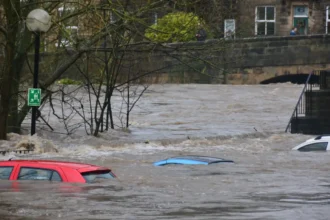Insurance companies will face massive bills of ₹12.27 lakh crore ($145 billion) from climate disasters in 2025, according to a new report from Swiss Re. This represents a concerning increase of nearly 6% from 2024’s ₹11.59 lakh crore ($137 billion) in insured losses. Swiss Re, a global reinsurance company that provides insurance for other insurers, released these findings on April 29, 2025.
The total economic damage from disasters in 2024 reached ₹26.91 lakh crore ($318 billion) worldwide, but insurance only covered 57% of these losses. This leaves a huge financial burden on governments, businesses, and families who must pay for recovery themselves.
Understanding the Protection Gap
The difference between total economic losses and what insurance covers creates a protection gap of ₹15.31 lakh crore ($181 billion). This gap shows how many people and places remain financially vulnerable to disasters. The protection gap exists because of several key reasons:
- Low insurance coverage in high-risk regions
- Rising costs making insurance unaffordable
- Insurance companies leaving dangerous markets
- Economic growth in vulnerable areas
According to Swiss Re, this gap highlights problems in how prepared we are for disasters. When you don’t have insurance, recovering from a disaster becomes much harder and slower.
California Facing Serious Challenges
Los Angeles wildfires have dramatically shown these problems. These fires destroyed about 16,000 buildings and forced thousands of people to leave their homes and businesses. Major insurance companies are now refusing to offer new policies in California because of wildfire risks.
According to InsuranceJournal, North America suffered the most, accounting for almost 80% of global insured losses in 2024. When your insurance company leaves your market, you face difficult choices about how to protect your property.
Why Disasters Are Getting Worse
Climate change is making weather disasters more frequent and severe. As more people build homes in dangerous areas like forests, coastlines, and floodplains, the potential for damage grows. Urban sprawl puts more buildings at risk.
These factors create a perfect storm for insurance problems. You might notice your insurance rates going up, or find it harder to get coverage if you live in a high-risk area.
Looking Ahead
The report warns there’s a one-in-ten chance that insured losses could reach ₹25.38 lakh crore ($300 billion) in 2025. This worrying possibility could further destabilize insurance markets and leave more people unprotected.
Swiss Re suggests that better building codes, improved disaster planning, and new insurance products could help address these challenges. You might need to think differently about how you protect your property in the future.
As climate disasters become our new normal, the gap between economic losses and insurance coverage presents a growing challenge. The question remains – are you prepared for a world where traditional insurance may no longer provide the safety net you’ve relied on?











